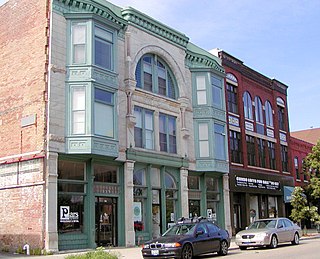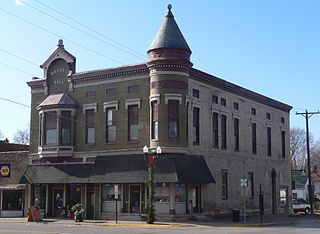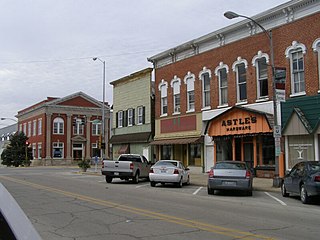
Orangeville is a village in Stephenson County, Illinois. The town's sign lists the population at 800 as of January 2021. The population in 2020 was 738. The population according to the 2010 census was 793, up from 751 in 2000. Using the 2020 population of 738 Orangeville is the 741st largest city in Illinois and the 11,650th largest city in the United States. Orangeville is currently declining at a rate of -0.94% annually and its population has decreased by -6.94% since the 2010 census. The area's earliest white settlers arrived in the year 1833, and the village was platted in 1851 by John Bower, who is considered the village founder. In 1867 Orangeville was incorporated as a village. The town's central business district contains several 19th century commercial buildings, many of which were built during the railroad boom of 1888–1914. By the time the Great Depression was ongoing, business in Orangeville had started to decline, with the last bank closing in 1932. In 1956 another bank started operating in the village and is still in town today. Some recent infrastructure jumps have restored some of the village's old decor.

The Sycamore Historic District is a meandering area encompassing 99 acres (400,000 m2) of the land in and around the downtown of the DeKalb County, Illinois, county seat, Sycamore. The area includes historic buildings and a number of historical and Victorian homes. Some significant structures are among those located within the Historic District including the DeKalb County Courthouse and the Sycamore Public Library. The district has been listed on the National Register of Historic Places since May 2, 1978.

The Bloomington Central Business District is a historic district in downtown Bloomington, Illinois. The district includes roughly twelve square blocks of the city and encompasses 140 buildings, 118 of which are contributing buildings to the district's historic character. The 1901 McLean County Courthouse, the center of government of McLean County, is the focal point of the district. The other buildings in the district were built between 1842 and 1942 and are primarily commercial. The Miller-Davis Law Buildings, two of the oldest buildings in the district, were built in 1843 and represent the early period of Bloomington's development. Bloomington's commercial core grew rapidly during the 1850s and 1860s after two railroads opened in the city; while the 1854 Gridley Bank is the only surviving pre-1857 building from this period, several more remain from the later part of the boom. The city continued to grow, and its business district continued to expand, from 1860 until 1900; however, a fire destroyed much of its downtown in 1900. Several buildings in the district date from the rebuilding period of the early 1900s.

The Scales Mound Historic District is a historic district in the small Illinois village of Scales Mound. The district encompasses the entire corporate limit of the village and has more than 200 properties within its boundaries. The district was added to the U.S. National Register of Historic Places in 1990.

The Greensburg Downtown Historic District is a national historic district located at Greensburg, Decatur County, Indiana. It encompasses 67 contributing buildings and 3 contributing objects in the central business district of Greensburg. The district developed between about 1854 and 1945, and includes notable examples of Italianate, Queen Anne, and Classical Revival style architecture. Located in the district are the separately listed Decatur County Courthouse and Knights of Pythias Building and Theatre. Other notable buildings include the Palmer Building, YMCA (1915), City Hall (1874), U.S Post Office, George E. Erdmann Building (1908),.

The Moline Downtown Commercial Historic District is a nationally recognized historic district located in Moline, Illinois, United States. Centered on 5th Avenue, it is roughly bounded by 12th Street to 18th Street, 4th Avenue to 7th Avenue. The distinct covers 33-acre (0.13 km2) and includes 114 buildings. One hundred of the buildings contribute to the significance of the district because they retain their historic and architectural integrity and reflect the character of the historic downtown.

The Morris Downtown Commercial Historic District is a historic district in downtown Morris. The district includes 116 buildings and a monument; 105 of these are commercial buildings, and 87 are contributing properties to the district.

The Centralia Commercial Historic District is a historic commercial district comprising several blocks of Broadway in downtown Centralia, Illinois. The district includes 57 contributing buildings as well as a historic water tower and sign. Centralia's business district developed around the Illinois Central Railroad tracks, as the town was established by and named for the railroad. The earliest buildings in the district date from the 1850s, as the city was platted in 1853. Centralia's first commercial buildings were mainly designed in the Italianate style, which was predominant until the end of the 19th century; the Romanesque Revival style also gained popularity in the 1880s. Around the turn of the century, the Commercial style became the most popular style in the district. The Renaissance Revival and Classical Revival styles can also be seen in buildings from this era, and by the 1930s Art Deco and Modernist architecture became popular.

The Monticello Courthouse Square Historic District is a historic district in downtown Monticello, Illinois. The district includes the historic commercial center of the city, the county seat of Piatt County, and is centered on the Piatt County Courthouse. 80 buildings are included in the district, 73 of which are considered contributing to its historic character. The district was added to the National Register of Historic Places on November 5, 2009.

The Commercial Row–Brickelltown Historic District is a historic district in downtown Truckee, California. Developed from 1870 to 1930, the district includes the significant parts of Truckee's early commercial district. Due to several major fires, the district had several distinct construction and rebuilding periods; the fires also destroyed several significant buildings, including the stagecoach station which established the site of the city's downtown. To protect them from fires, most of the surviving commercial buildings were built with stone or brick. Once the Central Pacific Railroad was completed through Truckee in 1869, it became one of the city's main economic drivers; the Commercial Row district's businesses mainly catered to workers and travelers on the railroad. The Brickelltown district, meanwhile, housed and served workers in Truckee's other main industry, lumber. In the twentieth century, both industries declined due to economic shifts and the Great Depression; the city, and Commercial Row in particular, instead built a tourist economy on visitors to the region's recreational activities.

The Decatur station, also known as the Wabash Railroad Station and Railway Express Agency, is a historic railway station located at 780 East Cerro Gordo Street in Decatur, Illinois. Built in 1901, the station served trains on the Wabash Railroad, the most economically significant railroad through Decatur. Architect Theodore Link designed the Classical Revival building. Service to the station ended in the 1980s, and it has since been listed on the National Register of Historic Places.

The Downtown East St. Louis Historic District is a historic commercial district in downtown East St. Louis, Illinois. The district includes 35 buildings, 25 of which are contributing buildings, along Collinsville Avenue, Missouri Avenue, and St. Louis Avenue; all but one of the buildings was historically used for commercial purposes. While development in the area dates back to the late 19th century, the first of the extant buildings in the district were built around 1900 after a tornado devastated the area in 1896. By 1910, the area had become a prosperous commercial district with stores, offices, and entertainment venues; surviving buildings from this period include the Murphy Building and the Cahokia Building. Another large building boom took place in the 1920s, adding buildings such as the Spivey Building, the city's only skyscraper; the Union Trust Bank Company Building, the largest bank in the city; the Grossman Building; and the Majestic Theatre. The new buildings both coincided with a population and economic expansion in the city and allowed it to forge an architectural identity distinct from neighboring St. Louis.

The Delavan Commercial Historic District is a historic district in downtown Delavan, Illinois. The district includes 26 buildings along two blocks of Locust Street, 20 of which are contributing buildings. The oldest buildings in the district, two simple brick commercial structures, were built around 1860. The remaining buildings were mainly built later in the 19th century, with a few built during the early 20th century. The buildings mostly have either Italianate or vernacular commercial designs, as was typical for commercial buildings of the period. Several of the buildings feature decorative metal elements such as storefronts, cornices, and window treatments. One notable exception to this design trend is the Masonic Hall at 401 Locust Street, which has a Queen Anne design featuring a large turret.

The Vermont Historic District is a national historic district located in downtown Vermont, Illinois. The district encompasses the commercial core of the village around Vermont's public square and along Main Street to the north; it includes 30 buildings, 23 of which are contributing buildings. The buildings in downtown Vermont functioned as the village's shopping and entertainment district as well as the home of fraternal halls such as the Vermont Masonic Hall. While commercial development in Vermont began in the 1840s, the oldest surviving building in the district dates to circa 1858; the building has a Greek Revival design, as was common among Vermont's early commercial buildings. A major building boom took place in the late 1860s and 1870s due to the village's rising population and railroad service; most buildings from this period have Italianate designs. Another building boom in the late 1880s and early 1890s brought several new Late Victorian buildings to the district. After the turn of the century, a number of Commercial style buildings were constructed as well.

The Downtown Commercial Historic District encompasses most of the central business district of Burlington, Iowa, United States. It was listed on the National Register of Historic Places in 2015. The historic district includes 65 properties that were part of a 2012 to 2013 survey of the area. It also includes as contributing properties the buildings in the West Jefferson Street Historic District and three buildings in the Manufacturing and Wholesale Historic District that were previously listed on the National Register. All total there are 122 resources within the district, which includes 108 contributing and 14 non-contributing properties.

The Downtown Momence Historic District is a national historic district which encompasses the commercial core of downtown Momence, Illinois. The district includes 49 contributing buildings, all but two of which are commercial buildings; the remaining two are residential. While the oldest building in the district dates to 1849, significant development in downtown Momence did not begin until the Chicago, Danville and Vincennes Railroad reached the city in 1871. Roughly one-third of the district's buildings, primarily retail stores, were built between 1871 and 1900. Most of the remaining buildings were built between 1900 and 1930; these were more diverse and included banks, entertainment and recreational facilities, and automobile-related businesses toward the end of the period. The architectural styles seen in the district are representative of American commercial architectural trends of the late 19th and early 20th centuries; the majority of the buildings have Italianate designs, though examples of Greek Revival, Classical Revival, and Romanesque Revival architecture can also be found in the district.

The Elgin Downtown Commercial District is a historic district encompassing the commercial core of downtown Elgin, Illinois. The district includes 94 buildings, 76 of which are considered contributing buildings to its historic character. While development in downtown Elgin began in the 1830s, the oldest buildings in the district were built in the 1870s; most of the district's buildings were built in the late 19th and early 20th centuries, but its development continued through the 20th century. The majority of the buildings in the district are two- and three-story commercial buildings, but it also includes several taller commercial buildings, churches, a public library, and a power station. Most of the 19th-century buildings in the district have Italianate or Queen Anne designs, while the 20th-century buildings features styles such as Colonial Revival and Renaissance Revival.

The Waterloo East Commercial Historic District is a nationally recognized historic district located in Waterloo, Iowa, United States. It was listed on the National Register of Historic Places in 2011. At the time of its nomination the district consisted of 36 resources, including 28 contributing buildings, and eight non-contributing buildings. The city of Waterloo was established in the early 1850s. Its first settlers started developing the west side of the city before crossing the Cedar River and developing east side. The first Black Hawk County Courthouse was built on the east side in 1856 and East Waterloo Township was created two years later. As industry began to develop along the river, and the arrival of the first railroad in 1861, the commercial district on the east side began to grow. Also on the east side of town was the terminus of the streetcar-turned-interurban system. By 1900, the city became one of the primary wholesale and retail centers in northeastern Iowa. In 1911 the Black population increased significantly as workers, primarily from Mississippi, moved into town to work for the Illinois Central Railroad. The following year the saloons in town were closed and bootlegging, gambling, drugs, and prostitution started to increase in the area surrounding the central business district. All of these developed put together created the atmosphere of the downtown commercial district.

The LaSalle Downtown Commercial District is a national historic district in downtown LaSalle, Illinois. The district encompasses 93 contributing buildings which historically formed the commercial and governmental center of LaSalle. Development in downtown LaSalle began with the completion of the Illinois and Michigan Canal in 1837 and the construction of railroads through the city in the 1850s; it continued through the mid-twentieth century. The district's commercial buildings represent many architectural styles, with popular styles of the late nineteenth century such as Italianate, Queen Anne, and Romanesque Revival being the most common. Significant government buildings include the LaSalle City Building and two post office buildings.

The Davenport Downtown Commercial Historic District is a nationally recognized historic district located in the central business district of Davenport, Iowa, United States. It was listed on the National Register of Historic Places in 2020. At the time of its nomination it consisted of 43 resources, which included 33 contributing buildings, one contributing structure, and nine non-contributing buildings. In addition, the district also contains 33 buildings that are individually listed on the National Register. This historic district is bordered by four other districts: the Crescent Warehouse Historic District and the Davenport Motor Row and Industrial Historic District on the east, the Hamburg Historic District to the northwest, and the West Third Street Historic District on the west.






















